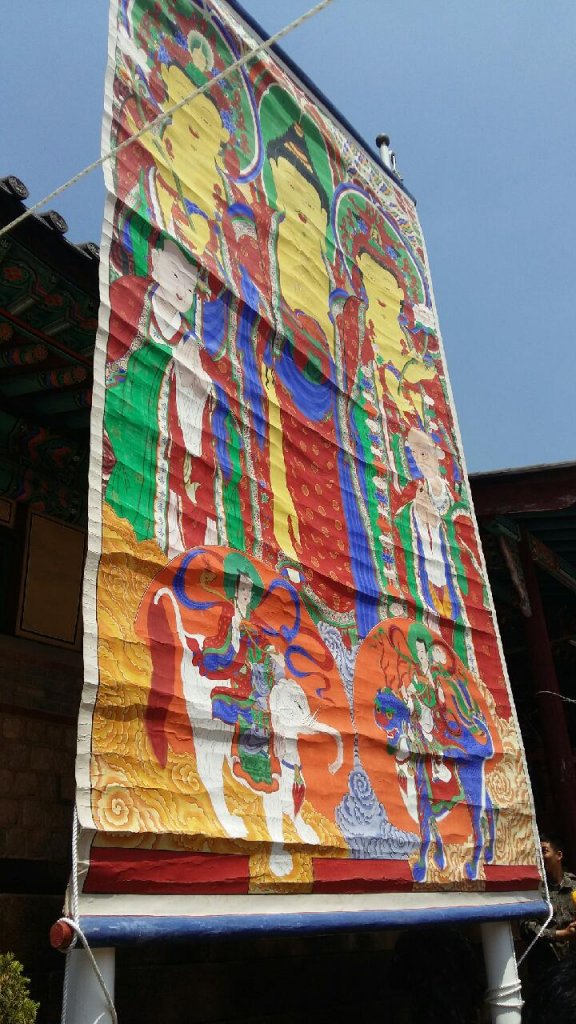
The largest Buddhist painting in Goyang City, Heungguksa Temple Hanging Painting
. In Buddhism, lions were recognized as symbols of illegal protection and were expressed in diverse forms from the Unified Silla Period to the Joseon Dynasty in sculpture, painting, and crafts.
. According to the chief monk's message, Goyang Nojeoksa Temple Lion Statue was excavated during the construction of a military barracks at an army base located at the entrance to Nojeongsa Temple in the 1970s
The statue was made using granite stone bricks built with Bukhansanseong Fortress, and It is presumed that it were made in the latter part of the Joseon Dynasty in terms of a square shaped torso and pedestal as well as a simpler leg compared to the body.
Tangible cultural property
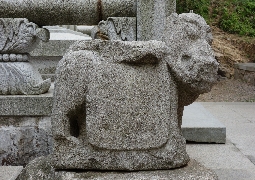
An unusual stone lion, Goyang Nojeoksa Temple Lion Statue
. In Buddhism, lions were recognized as symbols of illegal protection and were expressed in diverse forms from the Unified Silla Period to the Joseon Dynasty in sculpture, painting, and crafts.
. According to the chief monk's message, Goyang Nojeoksa Temple Lion Statue was excavated during the construction of a military barracks at an army base located at the entrance to Nojeongsa Temple in the 1970s
The statue was made using granite stone bricks built with Bukhansanseong Fortress, and It is presumed that it were made in the latter part of the Joseon Dynasty in terms of a square shaped torso and pedestal as well as a simpler leg compared to the body.
Buddhist art
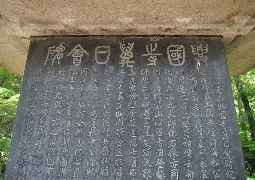
The precious monument holding Buddhist memorial services for 30 years, Hanmisan Heungguksa temple Manilhoibi tombstone
. in 1929, Hanmisan Heungguksa temple Manilhoibi tombstone was raised money by Haesong, who is the chief priest of the Heungguksa temple and was written about Manil Buddhist prayer service by Jeongho monk (Hanyoung Park, 1872-1948), who was staying at Jeeunsa temple.
include the history of the founding history of Heungguk Temple and the name of the temple in the latter part of Joseon Dynasty, as well as diverse Buddhist service records of Yaksajeon, Chilseongjeon, Nahanjeon, and Sanshin.
. Hanmisan Heungguksa temple Manilhoibi tombstone is the city's only record of the Goyang Buddhist faith regarding Manil Buddhist prayer meeting, which began to become popular nationwide in the 19th century. Also, it is important to note that the inscription tells us that Manil Buddhist prayer service was supported by the royal family at that time.
Hanmisan Heungguksa temple Manilhoibi tombstone is a tombstone produced in the modern era, but it also has history and origin of the temple as well as various records related to Manil Buddhist prayer service from the late of the Joseon Dynasty to modern times. For that reason, it is a historical treasure that shows Buddhist history, Buddhist faith, social and economic history, and supporting system in the early 20th century.
In addition, it has value in the study of Goyang local history as it contains our commitment to national independence movement during Japanese occupation.
Heungguksa temple Manilhoi gibi is a monument located inside Iljumumun Gate, the main gate of Heungguk Temple, and is designated as a local cultural property in Goyang City.
This monument is an inscription that was used to summarize the history of Heungguk Temple, which lasted more than a thousand years, and to deliver a Buddhist prayer service to future generations, especially from 1904 to 1928.
memorial stone consists of a pedestal, roof(Oakgae), and body(Bisin). Also, the inscription is written on both the right and left sides of the stone. The body(Bisin) is made of oak and the front is also marked with a distinctive inscription on it.
Epigraph
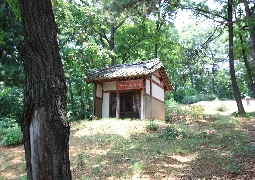
A devoted son who cut his finger for his parents, Jangeuijung filial memorial house
Jangeuijung's tomb and monument house, and memorial gate for the filial piety of Jangeuijung are located in the back hill of the entrance to Wanglinggol restaurant in Wongmyeong-dong, Deokyang-gu, is the only Confucian monument in Goyang City where the royal family and the filial memorial gate remain.
Jeonggeo(monument house) is a gambrel tile-roofed house in the form of a traditional Korean house and it has been partially remodeled with concrete due to its partial damage and the scale is two squares front. Inside, there are ancestral tablets and utensils used in ancestral rites.
In Jeonggeo(monument house), the word "Monument to the Filial Piety of Jangeuimoon" is written in white and the plates of the gate are red with 8 patterns and the filial memorial gate is supported by a wire connected by Jeonggeo(monument house).
Jangeuijung was a great son of the late Joseon Dynasty when he was told that he was trying to donate his finger to cure his mother's disease, and received the Jeonggeo(monument house) and and the filial memorial gate from King Gojong in 1905.
Jangeuijung's tomb is located 30m behind the gate.
monument house
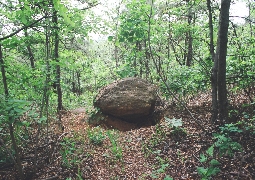
Dolmen even in Goyan city ? Guksabong jiseongmyogun
Designated number : Local cultural property no. 56, Goyang City
Location : Hwajeong-dong, Deokyang-gu, Goyang city, Gyeonggi-do
At the summit of Guksabong Peak, there is a large rock called Jangsa Rock, and there are many rocks scattered along the ridge from 20 to 30 meters below.
Based on the summit, the southern slope seems to have fallen off the peak of Guksabong Mountain, and the northern slope contains more than 20 fine stones.
Jangsa rock in the summit was over 10 meters straight, but some of it was destroyed when the army entered.
Given that there was such a huge rock, most of the rocks in this area were not moved elsewhere, but were used to escape from the roadbed exposed to the ground. Even if the dolmen was built, it would have been built using a roadbed.
The dolmen is easily seen on the way up and down the Guksa Peak.
The supporting stones are raised above the surface and the cover stone is well preserved, so it looks like a dolmen.
Prehistoric remains
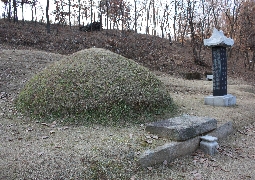
A loyal retainer who predicted the outbreak of the Japanese Invasion of Korea, YoonGil Hwang's tomb
Designated number : Local cultural asset No. 55
Location : 72-15, Deokyang-gu, Goyang city, Gyeonggi-do
Yoon-gil Hwang's tomb is located inside the Bukhansan unit, below Ok-myeon Peak in Jiax-dong, Deokyang-gu.
His family clan is Jangsu, name is Giljae,, and nickname is Woosongdang. In 1561 (the 16th year of the reign of Myeongjong), he passed the school entrance examination as a branch of the military service and became a public officer(Jeongeun) in 1563, and promoted to higher position(Jipyung) in 1567.
In 1585, he served as a pastor in Hwanghua, and he reached the vice minister in the ministry of war.
In 1590, I was dispatched to Japan by a news agency to meet HideyoshI Toyotomi, and returned to Korea the following year to prepare for the incident.
His report was opposed to Sungil Kim, but the government turned a deaf ear to his opinion because the Dongin people were strong
According to his prediction in the spring of 1592, King Seonjo reportedly regretted not following his words when the Japanese invasion of Korea broke out.
The tomb of Yoongil Hwang presumed to be built in 1592 when Usongdang passed away, which is the same time when the Japanese invasion of Korea, but it is believed that the stone bricks were not able to installed during the war so it assumes to be about 400 years old.
The material of stone is granite and the stone before a tomb that the incense burner is put on, located in front of the head of the table, was installed in 1982 for the ceremony.
Since the memorial stone and inscription were not handed down, it was built based on the works of descendants in 1982, referring to ancient documents such as the annals of the dynasty and the Jingbirok.
The tomb of Yoon-gil Hwang is the tomb of a loyalist who is under the supervision of the army.
Burial ground
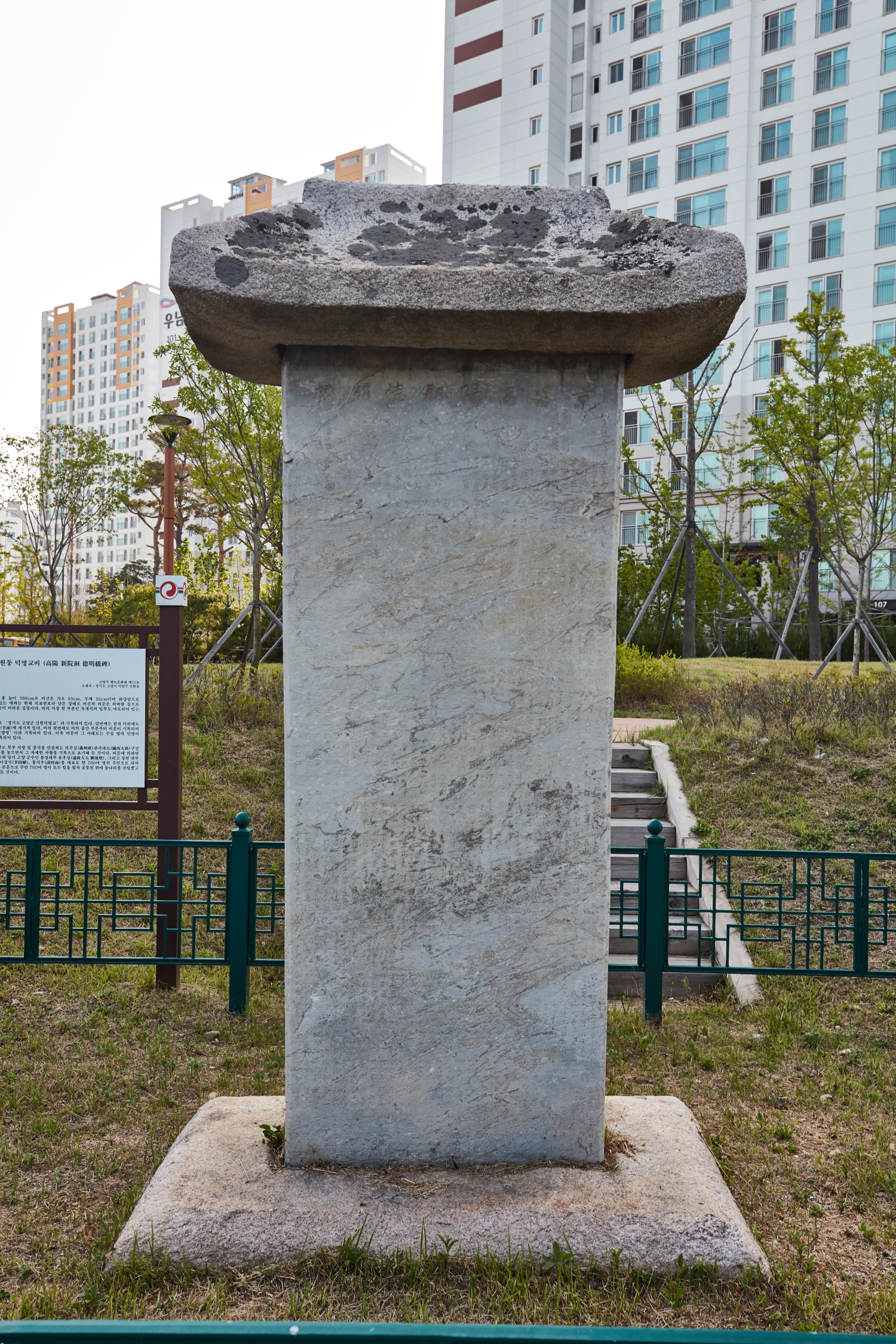
Shin Won-dong Deokmyung KyobI(bridge tombstone), recorded by Lee Du-moon and Idu
Designated number : Local cultural asset No. 52
Location : 1685 Sinwon-dong, Deokyang-gu
This tombstone is located on soccer practice field of small and medium industrial Bank of Korea in Haebangchon village in Shinwon-dong.
Now it has almost all of the pedestal buried in the ground and the entire material is granite and some of the jade stones are worn out.
On the front of the monument, the inscription " Deokmyeonggyo Bridge, Goyang County, Gyeonggi-do " is written as Chinese characters.
On the front, there is an inscription written in fine letters besides the former as well.
On the back of the monument, the inscription is written from the middle of the monument, and it is written as 'Goyangsiwon Deokmyeong Korangmyung'.
And below that are dozens of names written in Idu characters.
And below that are dozens of names written in Idu characters. The content of the monument is about all details when the bridge was placed over the Kongreungcheon stream in Shinwon-dong connecting Hanyang and Northern region.
According to the inscription, this monument's builders consist of Ihan, Yoon Hu-sung Ahn who was the governor of Goyang at that time, and about 760 residents representing Myunji Yoon, Sang-sik Lee, and Si-woo Hong.
In other words, the front of the monument was recorded detailed description of the list of 760 inhabitants by showing their power to build the stone bridge over the Kongreungcheon stream.
The construction date for this bridge is the ninth year of Hyojeong (1658).
As a memorial stone for the history of Goyang Stream in Goyang City, it is regarded as a valuable cultural asset.
Bigal
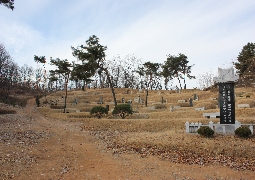
Tomb of Jinam Kim, a character in the late Joseon Dynasty who built Junggyebi in Baekdu Mountain
Designation number: Regional cultural asset 51
location: 195-5 Ogeumdong-san, Deokyang-gu, Goyang-si, Gyeonggi-do
Tomb of Jinam Kim is located at the tomb of Ubong Kim to the right side of Ogeumdong Sootdolgogae, and Sangseok and Hyangroseok are located in the tomb of Jinam Kim. Especially, important historical facts are recorded on the tomb. It says the record of how he climbed up to Baekdusan Mountain during the reign of Sukjong and established Junggyebi of Baekdusan after making the boundary clear with ambassadors in Cheong. Contents of the tomb are as follows.
The emperor Gangui investigated the northern areas by dispatching Mokgeukdong, but Joyang was suspicious and concerned.
Bulcho was performed even if the Jubbansa Kwon Park asked the king for the sake of Gong.
What Mokgeukdong said Gong was that ‘Since the boundary was not clear on the areas 2-3 kilometers to the west of Duman River and to the east of Aprokgang Rive, citizens tend to pass through the boundary. Therefore, king has ordered to screen them for passing the boundary.’
What Gong answered was that ‘Both rivers really became the boundaries and also the areas below the river when seen from the origin of Namsang. Therefore, it is still difficult for us to consider them as a boundary between two countries.’
They followed Mokgeungdong since he was accurate. At last, they built stones at where water came out from the peak of Baekdu Mountain and setup the boundaries. According to the records from literatures suich as annals of Joseon Dynasty, there are many of the related records.
However, it is a very rare case that Junggyebi was built among the royal tombs. Jinam Kim was a Yukgwan. His family clan was 牛蜂, and his name was 季明. His other name was 廣川. He passed one of the national exams and served as Yukgwan.
In addition, he wrote about Jacho ethod (boiling dist to make gunpowder) as a way to make gunpoweder as well as Sinjeonjachobang and Dongmungwanji. Jinam Kim was known to be Yukgwan and a character that achieved great accomplishment in the late Joseon Dynasty.
Burial ground
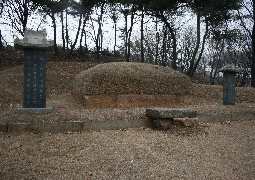
Rectangular Mounds in the early Chosun Dynasty, Eui-ong-gong Lee Sook Gyoon’s Tomb
Designated number : Local cultural asset No. 50
Location: 158-1, Siksa-dong, Ilsandong-gu, Goyang-si, Gyeonggi-do
Hee-ong-gong, Lee sook gyoon’s tomb is located in a park near Juh-hyun High School in Siksa-dong, Ilsandong-gu.
He was born in Taejo year 6 (1397) as a civil servant in early Chosun dynasty and passed in Sejong year 30 (1448). His posthumous epithet is Hee Ong Gong, name is Gyoonpyung, family clan is Danyang, and is the grandson of Ikpyunggong, the second vice premier Dansan official, Lee Moo.
In Sejong year 5 (1423), he worked on provincial government posts and had a lot of achievements including numerous policies to protect the western area. In Sejong year 8 (1426) he was appointed as the Moksa of Gwangju and Busa of Kangleung, but passed before he could leave for a new post.
Sejong thought highly of his achievements, granted him a higher position and gave him an honorable funeral.
His tombstone, width 4m and height 5m, writes and has a rectangular mound with two statues of civil officials on the left and right side retaining its original form in the early days of Chosun Dynasty.
The grave has a width and height of approximately 4m and 5m respectively and has a rectangular shape common in the early days of Chosun dynasty.
According to previous studies, rectangular graves are a rare category but are common in Goyang-si.
Most graves of Goyang-si constructed before the year 1500 have rectangular mounds which is quite an interesting research subject.
Burial ground
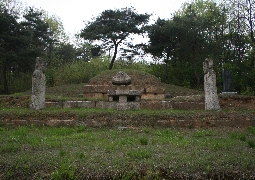
Grave of Sunguk, Father-In-Law of Prince Seongryeong
San 27, Daeja-dong, Deogyang-gu, Goyang-si, Gyeonggi-do
Sung-uk’s grave is located in Daeja-dong, Deogyang-gu.
Born in Goryeo Wuwang year 12 (1386), Hee-jung-gong Sung-uk passed in Chosun sejong year 30 (1448) and was granted a posthumous name of Hee-jung.
He was a civil servant of the early Chosun Dynasty whose family clan was Chang nyung and was the son of Suk-in, the Minister of Culture and Education.
From his family ties he worked in the public office and held various positions such as gong, cho, jung, and lang. In 1414, he held numerous positions including the governor of Cheonla province, advisory judge, and minister of war. His daughter married the fourth son of King Taejong, Sung nyung.
The grave is in the direction of Yubang and is surrounded with stones in a square shape and is lying along with Chungkyung’s wives, Jooksan An and Namyang Hong.
The grave, 394cm wide, 530cm long, 202cm high, is surrounded by two layers of supportive stones surrounding the mound which are carefully arranged preventing the mound from falling.
It is unique because on top of the supportive stones, there is another rectangular canal and in front of the mound there are Honyu stone, Sang stone, and Ko stone. The engraved statue is gone but the 2 civil servant statues remain retaining the form from the early Chosun Dynasty.
Burial ground
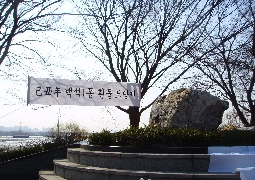
For the well being of the valley .. White Stone Memorial Ceremony of Baekseok
A hundred years old tradition, Baekseok-dong’s White stone memorial ceremony has been protecting the well-being of the village and has served as spiritual support for the village developed through unity and harmony of the people.
This memorial ceremony is held by the White stone preservation committee in lunar year March annually with the people of Beakseok-dong to preserve the folk culture of “White Stone” and wish the everlasting development of the valley.
This ceremony has been continued for the preservation of white stones and for the well being and prosper of the valley. However since last year, affected by the split of Baekseok-dong, preservation has become unclear and Baekseok-dong Committee has been in charge of the event, trying to attain tradition by anointing this as a local cultural asset.
Intangible cultural property(traditional ritual)










